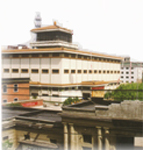 |
The Museum has collected 57,000 items of collection, fallen into the categories of painting and calligraphy, embroidery, copper ware, lacquerware, ancient map, coins, inscription on bones or tortoise shells, pottery and porcelain, cloisonné, sculpture, tablet inscription, furniture, costumes, archeology, relics of minority groups, revolutionary relics and ancient extinct animals and plants, of which 173 are Class One collection. The objects collected by the Museum include samples, models, photos, charts, rubbings and printing materials, totaling 18,000 articles. The times of collections extend from the Paleolithic Age to the present time. The collections mainly come from three resources, namely, the small number of collections left from the Fengtian Museum of the puppet regime, the historic relics collected during the Liberation War of the Northeast and the articles collected and unearthed after the founding of the New China.
Most of the collections of the ancient paintings and calligraphy are the artworks left from the Tang Dynasty (618-907), the Song Dynasty (960-1279) and the Yuan Dynasty (1271-1368), such as the replica of the Wang Xizhi'sYimenshuhanin the Tang Dynasty, thePainting of a Beauty Wearing Flowers in Hairby Zhou Fang in the Tang Dynasty, the calligraphy ofMengdiantieby Ouyang Xun, the calligraphy ofFour Ancient Poemsby Zhang Xu,the Painting of Ferry at the Mouth of Xiajingshanby Dong Yuan in the Five Dynasties (907-960),the Painting of Auspicious Cranedrawn by Zhao Jie, an emperor in the Song Dynasty, andthe Painting of Bailiansheby Li Gongli. There are also quite a few silk artworks handed down from the ancient times, such as theJingangjing(a Buddhist scripture) woven in the Five Dynasties, the scroll ofZiluanquepu, theKesi(a type of weaving done in fine silks and gold thread by the tapestry method) artwork from the Northern Song Dynasty (960-1127), theKesiofCamelliaandPeonyby Zhu Kerou from the Southern Song Dynasty (1127-1279), the embroidery ofRiding Crane in Yaotan(a legendry dwelling place for immortals) from the Song Dynasty (420-479), the embroidery ofJingangjing(a Buddhist scripture) from the Yuan Dynasty (1271-1368) and a Gu's embroidery ofMaitreya(a Budhistava usually represented as a very stout monk with a broad smile on his face and with his naked breast and paunch exposed to view) from the Ming Dynasty (1368-1644). In the ceramics category the colorful porcelains from the Liao Dynasty (916-1125) are also very special collections of the Museum. In the category of ancient map, Xu Lun'sJiubiantu(a map of nine sides) from the Ming Dynasty andComplete Map of the Worldby Matteo Ricci (also known as Li Madou in China) are both the only extant copy in China.
In the vast amount of unearthed items the comparatively important ones are the bronze jar andLei(an ancient urn-shaped drinking vessel) with the pattern of a coiled dragon from Shang Dynasty (c.1600-c.1100BC) and the Zhou Dynasty (c.1100-221BC), a bronze dagger unearthed from a tomb of the Spring and Autumn Period (770-476BC), a gold seal with a tortoise knob, a batch of glassware, a wood stirrup wrapped with gold-gilded copper, a white glazed long-necked bottle with flower patterns and a brown glazed pot in the shape of cockscomb unearthed from a Liao tomb, a scroll ofPainting of Bamboo, Sparrows and Two Rabbits, a scroll ofPainting of Playing Chess in Remote Mountains, and a pall ofKesiwith the pattern of gold dragons.
Since it was founded in 1949, the Museum has held more than ten large-scare exhibitions, such as the Exhibition of Classification of Historical Relics, the Exhibition of Historical Relics, the Exhibition of Chinese Artworks, the Exhibition of Chinese History and the Exhibition of Major Archeological Discoveries in Liaoning. The basic exhibition of the Museum is the Exhibition on Special Topic of Historical Relics of Liaoning, displaying the unique and colorful historical and cultural features of the Liaohe River Reaches and Dalinghe River Reaches as well as the coastlines of the Yellow River and Bohai Sea by concentrating on the best archeological relics of Liaoning. In addition, on the long-term display are the exhibition of stone carvings and the exhibition on the special topic of the porcelain left from the Ming Dynasty and the Qing Dynasty. Exhibitions on special topics and various kinds of mobile exhibitions are also frequently held. The Exhibition of the Calligraphy from the Ming and Qing Dynasties, the Exhibition of the Paintings from the Ming and Qing Dynasties, the Exhibition of Trio-Colored Glazed Pottery of the Tang Dynasty, the Exhibition of Bronze and Ceramics of China, and the Exhibition of Relics from Liaoning Province of China were held successively in Germany and Japan.
The Museum has published scores of large-scale relic categories and special works, includingSelections of Calligraphy Collected by Liaoning Provincial Museum,Selections of Paintings Collected by Liaoning Provincial Museum,China Museum Series -- Liaoning Provincial Museum,Kesiand Embroidery Collected by Liaoning Provincial Museum,Collection of Chinese Calligraphy -- Liaoning Provincial Museum,Liao Porcelain Collection of Liaoning Provincial Museum,Collection of Qi Baishi's Paintings,Paintings of Prosperous Suzhou,Collection of Gao Qipei's Paintingsand an archeological report ofMiaohoushan Mountainin addition tothe Collection of Academic Papers of Liaoning Provincial Museum.